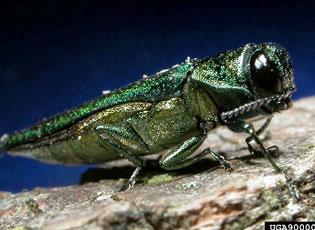Agrilus planipennis Fairmaire, 1888 (ITIS)
Emerald ash borer (EAB)
Eastern Russia, Northern China, Japan, and Korea (McCullough and Usborne 2015)
2002 (McCullough and Usborne 2015)
Arrived accidentally in cargo imported from Asia (McCullough and Usborne 2015)
Ash trees lose most of their canopy within 2 years of infestation and die within 3-4 years (McCullough and Usborne 2015; Poland and McCullough 2006)

Emerald Ash Borer, Adult
David Cappaert
Find more images
Spotlights
Distribution / Maps / Survey Status
All Resources
Selected Resources
The section below contains highly relevant resources for this species, organized by source.
Council or Task Force
Partnership
Federal Government
International Government
State and Local Government
Academic
Integrated Taxonomic Information System. Agrilus planipennis. [Accessed Aug 31, 2023].
